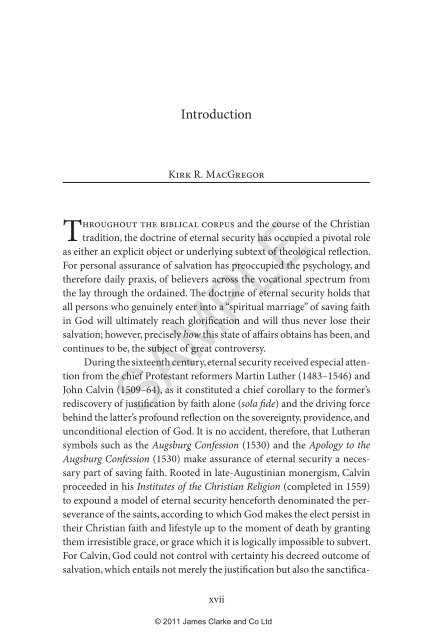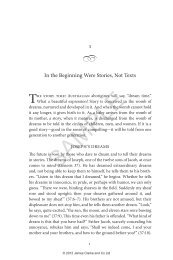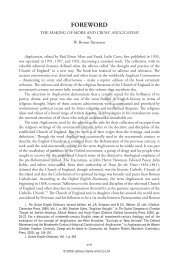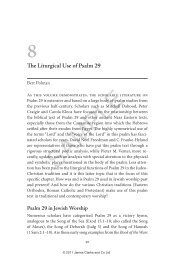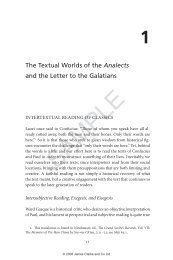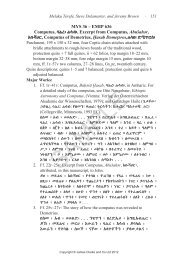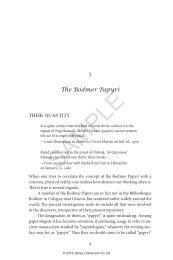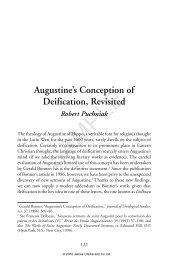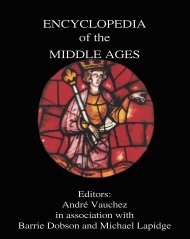Introduction by Kirk R. MacGregor - James Clarke and Co Ltd
Introduction by Kirk R. MacGregor - James Clarke and Co Ltd
Introduction by Kirk R. MacGregor - James Clarke and Co Ltd
You also want an ePaper? Increase the reach of your titles
YUMPU automatically turns print PDFs into web optimized ePapers that Google loves.
<strong>Introduction</strong><br />
<strong>Kirk</strong> R. <strong>MacGregor</strong><br />
Throughout the biblical corpus <strong>and</strong> the course of the Christian<br />
tradition, the doctrine of eternal security has occupied a pivotal role<br />
as either an explicit object or underlying subtext of theological reflection.<br />
For personal assurance of salvation has preoccupied the psychology, <strong>and</strong><br />
therefore daily praxis, of believers across the vocational spectrum from<br />
the lay through the ordained. The doctrine of eternal security holds that<br />
all persons who genuinely enter into a “spiritual marriage” of saving faith<br />
in God will ultimately reach glorification <strong>and</strong> will thus never lose their<br />
salvation; however, precisely how this state of affairs obtains has been, <strong>and</strong><br />
continues to be, the subject of great controversy.<br />
During the sixteenth century, eternal security received especial attention<br />
from the chief Protestant reformers Martin Luther (1483–1546) <strong>and</strong><br />
John Calvin (1509–64), as it constituted a chief corollary to the former’s<br />
rediscovery of justification <strong>by</strong> faith alone (sola fide) <strong>and</strong> the driving force<br />
behind the latter’s profound reflection on the sovereignty, providence, <strong>and</strong><br />
unconditional election of God. It is no accident, therefore, that Lutheran<br />
symbols such as the Augsburg <strong>Co</strong>nfession (1530) <strong>and</strong> the Apology to the<br />
Augsburg <strong>Co</strong>nfession (1530) make assurance of eternal security a necessary<br />
part of saving faith. Rooted in late-Augustinian monergism, Calvin<br />
proceeded in his Institutes of the Christian Religion (completed in 1559)<br />
to expound a model of eternal security henceforth denominated the perseverance<br />
of the saints, according to which God makes the elect persist in<br />
their Christian faith <strong>and</strong> lifestyle up to the moment of death <strong>by</strong> granting<br />
them irresistible grace, or grace which it is logically impossible to subvert.<br />
For Calvin, God could not control with certainty his decreed outcome of<br />
salvation, which entails not merely the justification but also the sanctifica-<br />
SAMPLE<br />
xvii<br />
© 2011 <strong>James</strong> <strong>Clarke</strong> <strong>and</strong> <strong>Co</strong> <strong>Ltd</strong>
<strong>Introduction</strong><br />
tion of the elect, without controlling with certainty the necessary means<br />
on which the outcome depends. The systematic nature <strong>and</strong> logical consistency<br />
of Calvin’s model rendered it a quite attractive export to Reformed<br />
communities in the Netherl<strong>and</strong>s, France, <strong>and</strong> Scotl<strong>and</strong>. Moreover, in<br />
Engl<strong>and</strong> the traditional quasi-Catholic exterior of the church received<br />
new life from the Calvinist doctrinal stream. This stream’s perception of<br />
biblical fidelity led opponents of the Anglican Church who migrated to<br />
the New World, notably the Puritans <strong>and</strong> Particular Baptists, to place perseverance<br />
of the saints at the center of their theology.<br />
Perseverance of the saints emerged to a position of prominence across<br />
the American religious l<strong>and</strong>scape as a result of the First (c. 1730–1760)<br />
<strong>and</strong> Second (c. 1800–1830) Great Awakenings, nineteenth-century evangelical<br />
revivalism characterized <strong>by</strong> Charles G. Finney (1792–1875) <strong>and</strong><br />
Dwight L. Moody (1837–1899), <strong>and</strong> the Princeton school of Calvinist orthodoxy<br />
(c. 1810–1920). Starting among the Calvinistic Dutch Reformed<br />
<strong>and</strong> Pres<strong>by</strong>terians of the middle colonies, the First Great Awakening<br />
spread to <strong>Co</strong>ngregationalist New Engl<strong>and</strong> through the efforts of Jonathan<br />
Edwards (1703–1758), arguably the foremost American theologian. In<br />
his sermons <strong>and</strong> treatises, Edwards emphasized the sovereignty <strong>and</strong> the<br />
love of God, maintaining that all who have embraced Christ are continually<br />
<strong>and</strong> infallibly drawn <strong>by</strong> God’s love to himself <strong>and</strong> to his service over<br />
the course of life. 1 Although unabashedly Reformed in his conviction<br />
that those who embrace Christ were first predestined to do so, Edwards’<br />
message, echoed as it was <strong>by</strong> Particular (or Regular) Baptist preachers,<br />
gradually became attached in the popular mindset to the notion of conversion:<br />
once individuals passed out of “nominal Christianity” through<br />
born-again experiences where they, <strong>by</strong> repentance <strong>and</strong> faith, became new<br />
creatures in Christ, they were forever sealed <strong>by</strong> the Holy Spirit for the<br />
day of salvation. By the time of the Second Great Awakening, pastors<br />
<strong>and</strong> theologians without Reformed persuasions proclaimed a new variant<br />
on eternal security representing a theological halfway house between<br />
synergism <strong>and</strong> monergism, where those who freely chose to respond to<br />
God’s prevenient grace are then supernaturally preserved in faith until<br />
beatitude. This variant arose as a regular ingredient in the frontier preaching<br />
of camp meetings <strong>and</strong> tent revivals, alongside the Reformed model of<br />
perseverance which received fresh propagation at the h<strong>and</strong>s of Princeton<br />
SAMPLE<br />
1. Cairns, Christianity, 367.<br />
xviii<br />
© 2011 <strong>James</strong> <strong>Clarke</strong> <strong>and</strong> <strong>Co</strong> <strong>Ltd</strong>
<strong>Introduction</strong><br />
Theological Seminary professors Archibald Alex<strong>and</strong>er (1772–1851),<br />
Charles Hodge (1797–1878), A. A. Hodge (1823–1886), <strong>and</strong> Benjamin B.<br />
Warfield (1851–1921).<br />
In the twentieth century, a third view of eternal security began to take<br />
shape which depended entirely on justification rather than on sanctification,<br />
often referred to <strong>by</strong> its proponents <strong>and</strong> detractors under the moniker<br />
of “once saved, always saved.” Exp<strong>and</strong>ing upon the forensic justification<br />
introduced <strong>by</strong> Luther <strong>and</strong> codified <strong>by</strong> his successor Philip Melanchthon<br />
(1497–1560), this model avers that eternal security constitutes, within the<br />
internal logic of the Trinity, part of God the Father’s decision to declare<br />
the believing sinner at the moment of personal faith “not guilty” on the<br />
basis of the infinite penalty that God the Son has paid on the sinner’s behalf.<br />
Not only is this verdict irreversible, but, owing to the majesty of God’s<br />
grace, it persists for all eternity regardless of how the individual proceeds<br />
to behave or even whether the individual renounces faith in Christ. Unlike<br />
the Reformed <strong>and</strong> the Second Great Awakening insistence that assurance<br />
of salvation <strong>and</strong> personal holiness of life amount to two sides of the same<br />
coin, proponents of this third view radicalize the Reformation maxims of<br />
sola gratia <strong>and</strong> sola fide <strong>by</strong> distinguishing between repentance <strong>and</strong> faith<br />
(through which grace comes), denying the necessity of the former at any<br />
point in life but affirming the necessity of the latter at some point in life<br />
for eternal salvation. Earl D. Radmacher expounds this perspective with<br />
all-desirable clarity:<br />
Don’t confuse justification <strong>and</strong> sanctification. Tell unbelievers that<br />
if they simply believe in Christ they will at that moment have eternal<br />
life. That is justification <strong>by</strong> faith alone. . . . If an unbeliever asks<br />
if he must give up his sinful ways to have eternal salvation, tell him<br />
no. The only condition is faith in Christ. Tell him, however, that sin<br />
never pays, for the believer or the unbeliever, <strong>and</strong> that he should<br />
turn from his sinful ways whether or not he is convinced that Jesus<br />
gives eternal life to all who merely believe in Him for it. . . . Believe.<br />
Not repent. Not believe plus repent. Just believe. It’s that simple. 2<br />
SAMPLE<br />
Accordingly, this model assigns to repentance a primarily ethical function,<br />
where repentance focuses more on the horizontal dimension of social<br />
influence than the vertical dimension of union with God.<br />
2. Earl D. Radmacher, “Salvation: A Necessary Work of God,” in Underst<strong>and</strong>ing<br />
Christian Theology, gen. eds. Charles R. Swindoll <strong>and</strong> Roy B. Zuck (Nashville: Nelson,<br />
2003), 944.<br />
xix<br />
© 2011 <strong>James</strong> <strong>Clarke</strong> <strong>and</strong> <strong>Co</strong> <strong>Ltd</strong>
<strong>Introduction</strong><br />
Due to the prominence of the aforementioned three models<br />
throughout the past five centuries, it is little wonder that the vast majority<br />
of Western evangelicals associate eternal security with one of these.<br />
Nevertheless, these are far from the only ways Christians past or present<br />
have judged eternal security to be possible, as a plethora of views<br />
on theology proper, hermeneutics, <strong>and</strong> anthropology have produced<br />
numerous perspectives on eternal security from the biblical period<br />
onward. In an attempt to start remedying the knowledge gap, this first<br />
print anthology from Kevaughn Mattis’ online journal Testamentum<br />
Imperium features thirteen essays from an international array of scholars<br />
which bring a wide scope of scriptural, historical, <strong>and</strong> philosophical<br />
perspectives to bear on the question of eternal security. While all the<br />
contributors subscribe to the doctrine of eternal security, they do so in<br />
various ways, with a balance between adherents to the first two models<br />
(Calvin’s perseverance of the saints <strong>and</strong> the mediation between synergism<br />
<strong>and</strong> monergism) <strong>and</strong> exponents of other interpretations relatively<br />
unknown in the popular mindset.<br />
For the first time, this volume maps out the contours of a wide trajectory<br />
of eternal security from its Hebraic origins to contemporary theological<br />
developments. To accomplish this goal, the book is divided into two<br />
parts. Part One, “Biblical <strong>and</strong> Exegetical Studies,” analyzes <strong>and</strong> strengthens<br />
the canonical roots of eternal security which form the common foundation<br />
of all subsequent models of this doctrine. Part Two, “Historical <strong>and</strong><br />
Philosophical Studies,” considers issues of theological <strong>and</strong> social history<br />
as well as philosophy of religion which pertain to eternal security. Here we<br />
examine the understudied positions on eternal security of such thinkers<br />
<strong>and</strong> schools of thought as Clement of Rome (c. 40–99), Albrecht Ritschl<br />
(1822–1889), Karl Barth (1886–1968), <strong>and</strong> process theology, <strong>and</strong> we assess<br />
the practical impact of Calvin’s preaching on predestination on the<br />
daily lives of his spiritual charges. Moreover, we philosophically delineate<br />
the permanent changes to the overall course of history <strong>and</strong> the human<br />
nature of individual believers accomplished <strong>by</strong> the dual event of Christ’s<br />
death <strong>and</strong> resurrection as well as their implications for personal salvific<br />
assurance <strong>and</strong> Christian ethics.<br />
SAMPLE<br />
xx<br />
© 2011 <strong>James</strong> <strong>Clarke</strong> <strong>and</strong> <strong>Co</strong> <strong>Ltd</strong>
<strong>Introduction</strong><br />
PART ONE: BIBLICAL AND EXEGETICAL STUDIES<br />
In chapter one, Harold R. Holmyard III carefully draws together the exegetical<br />
threads of many Psalmic texts to argue that, while not explicitly<br />
formulated, the concept that those who belong to Yahweh will be preserved<br />
<strong>by</strong> Yahweh forever, rescuing them from even the murky prospects<br />
of the prevailing Ancient Near Eastern Sheol afterlife model, is clearly<br />
affirmed. <strong>Co</strong>ntra the Documentarian source dating of the origin of belief<br />
in general resurrection to the Second Temple Period, Holmyard finds<br />
provocative traces of resurrection belief in such Davidic Psalms as 16 (vv.<br />
9–10), 17 (vv. 14–15), 37 (vv. 10–13, 28–29, 35–38), <strong>and</strong> 49 (vv. 14–15).<br />
Furthermore, Holmyard examines the implications of the Hebrew vocabulary<br />
for “forever” to demonstrate that the righteous possess a permanent<br />
hope of consciously living in the presence of God beyond the grave (e.g.<br />
23:6; 25:3; 30:12; 41:12–13; 121:7–8). Holmyard’s panoramic treatment<br />
of the book of Psalms then turns to the eternality of God’s love toward<br />
his faithful ones (e.g. 118:1–4, 29; 136; 138:8), revealing that its unfailing<br />
nature logically entails the permanent existence of all its objects. Since the<br />
Hebrew Bible does not deal with the theological issue of persevering in the<br />
faith with the same directness as the New Testament, Holmyard employs<br />
canonical synthesis to, in light of later revelation, unpack the ramifications<br />
of Psalmic motifs <strong>and</strong> images as they pertain to salvific endurance.<br />
Here Holmyard persuasively makes the case that the Psalms proclaim<br />
a God who enables all genuinely devoted to the Shema to persevere in<br />
their convictions throughout life, through his empowerment (e.g. 27:2–6;<br />
31:19–24), forgiveness (e.g. 25:12–18; 40:4–12), care (e.g. 22:24; 36:5–7),<br />
<strong>and</strong> protection (e.g. 17:4–5; 37:17–28; 71:20; 91). For the Psalms simultaneously<br />
bestow assurance upon those struggling to endure <strong>and</strong> expect the<br />
righteous to endure, blossoming like a palm tree or cedar which continues<br />
to bear fruit into old age <strong>and</strong> so illuminating the majesty of God.<br />
Chapter two, authored <strong>by</strong> J. Ramsey Michaels, broadly examines the<br />
prism of eternal security texts in John through the laser of an exceptional<br />
text-critical treatment of John 10:28–30, which greatly strengthens the<br />
connotations of both this foundational passage <strong>and</strong> the larger theme<br />
it represents. Reasoning from st<strong>and</strong>ard principles of textual criticism,<br />
Michaels conclusively establishes the impossibility that the common<br />
tautological translation of verse 29, “My Father, who has given them to<br />
me, is greater than all, <strong>and</strong> no one can snatch them out of my Father’s<br />
SAMPLE<br />
xxi<br />
© 2011 <strong>James</strong> <strong>Clarke</strong> <strong>and</strong> <strong>Co</strong> <strong>Ltd</strong>
<strong>Introduction</strong><br />
h<strong>and</strong>,” reflects the Johannine autograph. Rather, the original text of John<br />
pronounced, “That which my Father has given to me is greater than all,<br />
<strong>and</strong> no one can snatch it out of the Father’s h<strong>and</strong>,” indicating the supreme<br />
greatness of Jesus’ sheep <strong>and</strong> their collective identity as a most precious<br />
gift <strong>by</strong> the Father to the Son. Due both to the irrevocable nature of the<br />
Father’s gift to the Son <strong>and</strong> to the infinite worth of believers, both individually<br />
<strong>and</strong> collectively, in the Father’s sight, the salvation of believers is<br />
forever secure. Relating it to John the Baptist’s maxim that “a person can<br />
receive nothing unless it is given to him from heaven” (3:27), Michaels<br />
places this promise in the larger context of John’s Gospel, where it is seen<br />
that God the Father decides the citizenship of his Kingdom <strong>by</strong> drawing<br />
disciples, who then validate their status as an intertrinitarian gift <strong>by</strong> coming<br />
to Jesus. In the high-priestly prayer of John 17, Jesus substantiates<br />
this reasoning <strong>by</strong> placing his disciples, past <strong>and</strong> present, in his list of gifts<br />
the Father has bestowed upon him (vv. 6, 9, 24). Given this assessment,<br />
Michaels closes his essay <strong>by</strong> displaying its added hermeneutical value for<br />
fully underst<strong>and</strong>ing the multilayered meanings of Christ’s parables about<br />
the treasure in the field <strong>and</strong> the pearl of great price (Matt 13:44–46),<br />
which are now seen to span two vantage points. For believers, the treasure<br />
<strong>and</strong> the pearl connote the Kingdom of God; but for Jesus himself, the<br />
treasure <strong>and</strong> the pearl allude to the company of the redeemed, an insight<br />
corroborated <strong>by</strong> a rare but probable logia Jesu from the Gospel of Philip<br />
independent of the canonical Gospels.<br />
Branching out from this locus classicus <strong>and</strong> building on the hermeneutical<br />
groundwork laid <strong>by</strong> Michaels, the next two chapters continue in<br />
Johannine studies with detailed analyses of individual pericopae furnishing<br />
unshakable assurance of the believer’s salvation.<br />
In chapter three, Shawn L. Buice probes John 6:38–40 for its ability<br />
to reveal the will of God, cognizance of which is vitally important for<br />
Christian discipleship <strong>and</strong> yet often seems a la<strong>by</strong>rinth incredibly difficult<br />
to decipher in particular life situations for laypeople <strong>and</strong> theologians<br />
alike. This confusion is increased <strong>by</strong> the nature of the scriptural witness<br />
itself: unlike such codes of religious law as the Jewish Mishnah or<br />
the Theravada Buddhist Vinaya Pitaka, the Bible features an absence of<br />
texts straightforwardly explaining what to do when faced with particular<br />
situations. However, John 6 explicitly identifies the will of God as, first,<br />
Jesus losing none of those the Father has entrusted him but resurrecting<br />
them on the last day, <strong>and</strong> second, the eternal life plus final resurrection,<br />
SAMPLE<br />
xxii<br />
© 2011 <strong>James</strong> <strong>Clarke</strong> <strong>and</strong> <strong>Co</strong> <strong>Ltd</strong>
<strong>Introduction</strong><br />
presented as an amalgamated whole, of everyone who puts their trust in<br />
Jesus. Buice relates this exposure to the pragmatic aspects of the larger<br />
Johannine Christology, which in part present Jesus as a divinely commissioned<br />
agent whose desire is to accomplish the Father’s will. Admitting<br />
that a specific group of people, “those he has given me,” are referred to in<br />
John 6:38–40, Buice follows R. C. H. Lenski <strong>by</strong> arguing that this concession<br />
does not dem<strong>and</strong> limiting the number of persons who can acquire<br />
salvation to a divinely pre-selected company. Rather, Buice interprets the<br />
further description of this group, “everyone who sees the Son <strong>and</strong> believes<br />
in him,” as a universal invitation which removes all religious <strong>and</strong> ethnic<br />
boundaries <strong>and</strong> places membership priority upon the hearer’s decision.<br />
St<strong>and</strong>ing in a Baptist tradition borne out of both Particular <strong>and</strong> General<br />
Baptist streams, Buice marshals John 6 as support for a view denominated<br />
“preservation of the saints,” which mediates between synergism <strong>and</strong> monergism<br />
<strong>by</strong> drawing a distinction between the steps in the ordo salutis for<br />
which the individual <strong>and</strong> God are primarily, but not exclusively, responsible.<br />
Moreover, Buice maintains that a “preservation” model carries with<br />
it the pastoral advantage of preparing believers to rely exclusively upon<br />
God’s strength for carrying out the good, so escaping the psychological<br />
damage caused <strong>by</strong> thrusting believers back upon themselves for the responsibility<br />
of achieving sanctification.<br />
Chapter four treats the divine counsels reached prior to the creation<br />
of the space-time universe, as revealed <strong>by</strong> the high-priestly prayer in<br />
John 17. Here Jon Balserak insists that, far from an esoteric consideration<br />
with no practical relevance, a proper underst<strong>and</strong>ing of these counsels is<br />
imperative for the believer’s security. Balserak sheds light on their significance<br />
<strong>by</strong> recalling the Patristic controversy between Heracleon ( fl.<br />
175), a Valentinian Gnostic who composed the first commentary on<br />
John’s Gospel, <strong>and</strong> the prominent early church leader, philosopher, <strong>and</strong><br />
exegete Origen (185–254). On the one h<strong>and</strong>, Heracleon proposed that, for<br />
John, faith in Christ was a matter predetermined <strong>by</strong> a person’s conception<br />
<strong>by</strong> either God or the devil. On the other h<strong>and</strong>, Origen responded in his<br />
own Johannine commentary that belief was a matter of human free will.<br />
Dissenting from Heracleon’s interpretation of the pre-temporal counsels<br />
while not necessarily agreeing with Origen, Balserak avers that John 17<br />
evinces an overarching covenant of redemption, whose parties are the<br />
Father <strong>and</strong> the Son sans any creaturely envoy. Established before the world’s<br />
foundation, this covenant stipulates that the Father will choose a people<br />
SAMPLE<br />
xxiii<br />
© 2011 <strong>James</strong> <strong>Clarke</strong> <strong>and</strong> <strong>Co</strong> <strong>Ltd</strong>
<strong>Introduction</strong><br />
<strong>and</strong> entrust them to the Son, who will serve as their representative head;<br />
via his active <strong>and</strong> passive obedience, the Son will merit for this people<br />
all the treasures of beatitude. Therefore, it is the responsibility of Jesus to<br />
ensure that all believers ultimately obtain salvation, which proffers believers<br />
an inner peace that transcends the vicissitudes of contingency. In this<br />
light, Jesus’ prayer can be seen as his request of confirmation that when he<br />
completes the Father’s work, he <strong>and</strong> his people will receive the covenanted<br />
reward. Not merely content to verify this reward, Jesus displays supreme<br />
guardianship <strong>and</strong> compassion <strong>by</strong> adding a number of specific entreaties<br />
for the Father to prevent the flock from losing their salvation. Balserak<br />
points out that the covenant of redemption coupled with its dominical<br />
reinforcements furnish an unshakable ground for salvific assurance even<br />
amid believers’ struggles with the gravest internal sense of sinfulness.<br />
In chapter five, Stephen Voorwinde employs a close reading of<br />
Romans 8:31–39 to spell out precisely how God’s love functions as the basis<br />
<strong>and</strong> substance for the security of the believer. Framed <strong>by</strong> three forensic<br />
questions <strong>and</strong> one relational question, Paul powerfully declares that nothing,<br />
including believers themselves, will break the chain of God’s purpose<br />
for his adopted children, which extends from his foreknowledge to their<br />
glorification. Voorwinde shows the magnitude of this assertion <strong>by</strong> persuasively<br />
arguing, based on identifying the antecedent of “these things” (v.<br />
31) with either Paul’s treatment of divine grace covering chapters 5–8 or<br />
his argument in Romans up to this point, that it forms a conclusion to his<br />
entire discussion of Christian assurance. Voorwinde then explains how<br />
the provisions <strong>and</strong> promises of God shore up the assumptions behind<br />
each rhetorical question. For instance, Voorwinde notes that “God is for”<br />
believers in three different ways: he providentially arranges the circumstances<br />
of believers’ lives; he ordains an eternal purpose for believers;<br />
<strong>and</strong> he gives believers his Son. Moreover, Voorwinde helpfully addresses<br />
several objections raised <strong>by</strong> Paul’s opponents against his gospel which still<br />
comprise pressing matters for Christian praxis. <strong>Co</strong>ntrary to the perceived<br />
threat of antinomianism, Voorwinde highlights Paul’s contentions that<br />
believers died to sin through participation in Christ’s death, that believers<br />
died to the law <strong>and</strong> so are no longer yoked thereto, <strong>and</strong> that believers<br />
are therefore free to be yoked to Christ <strong>and</strong> share in the power of his<br />
resurrection through the Holy Spirit. To the issue of whether the word of<br />
God had failed as a result of its rejection <strong>by</strong> those first-century Jews who<br />
did not embrace the Way, Voorwinde unfolds Paul’s joint lines of reason-<br />
SAMPLE<br />
xxiv<br />
© 2011 <strong>James</strong> <strong>Clarke</strong> <strong>and</strong> <strong>Co</strong> <strong>Ltd</strong>
<strong>Introduction</strong><br />
ing that not all who are descended from Israel are members of Israel, for<br />
whom God’s priority in the gospel <strong>and</strong> promises in election still st<strong>and</strong>,<br />
<strong>and</strong> that the true Israel is revealed through the new way of the Spirit, the<br />
ultimate reality to which the Torah pointed. Voorwinde closes <strong>by</strong> illustrating<br />
how 8:35–39 utilize the twin foci of the death of Christ <strong>and</strong> the gift of<br />
the Spirit to draw together the threads of divine love in Romans, as God<br />
could never abdicate or refuse love to those in whom he has made such<br />
infinite investments.<br />
In chapter six, writing from a Calvinist st<strong>and</strong>point, Verlyn D.<br />
Verbrugge assesses the impact of 2 Peter 1:8–11 on the doctrine of election<br />
through analysis of the passage’s socio-historical background, grammar,<br />
<strong>and</strong> structure. Regarding background, Verbrugge shows that Peter is<br />
addressing two distinct groups—believers <strong>and</strong> false teachers—the latter<br />
of which were once affiliated with the church but have now capitulated<br />
to worldly corruption. This breakdown is significant because it shows<br />
that Peter did not have a third “transitional” group in mind composed<br />
of persons gradually sliding out of the group of believers <strong>and</strong> into allegiance<br />
with the false teachers; for Peter, anyone who joined the false<br />
teachers there<strong>by</strong> proved themselves to have never received the grace of<br />
God. Verbrugge cites approvingly the counterfactual insight of 1 John<br />
2:19, which indicates that the false teachers never actually belonged to<br />
the church since, if they had, they would not have ab<strong>and</strong>oned it. Placing<br />
2 Peter 1:8–11 in its context, Verbrugge reveals that the preceding verses<br />
1–7 display concern that believers escape sin <strong>and</strong> increasingly cultivate<br />
Christian virtues on the basis of the fact that they have received God’s allempowering<br />
gifts of faith, salvation, <strong>and</strong> the indwelling divine nature. This<br />
fact is corroborated <strong>by</strong> the use of ejpivgnwsi~ in verse 8, indicating that<br />
those charged to display the eightfold virtues of verses 5–7 possess the<br />
decisive saving knowledge of God rooted in personal conversion, which<br />
is precisely the knowledge that Peter later claims the false teachers have<br />
ignored. In verse 9’s description of the false teachers, Verbrugge maintains<br />
that the adverb pavlai (“long ago, in the past”) should not be linked with<br />
aJmartiw`n (“sins”), as though the false teachers were previously cleansed of<br />
their sins, but is a temporal indicator of when the false teachers heard, <strong>and</strong><br />
unfortunately ignored, the message of how to receive forgiveness. Upon<br />
examination of the major Greek terms in verse 10, Verbrugge concludes<br />
that “making sure” (poiei`sqai . . . bevbaio~) of one’s elective call means<br />
neither to cause nor to fortify one’s eternal salvation, but rather to confirm<br />
SAMPLE<br />
xxv<br />
© 2011 <strong>James</strong> <strong>Clarke</strong> <strong>and</strong> <strong>Co</strong> <strong>Ltd</strong>
<strong>Introduction</strong><br />
in one’s own heart the reality of God’s gracious work through one’s praxis,<br />
which could not transpire apart from one’s previous election.<br />
Chapter seven sees Francis Lyall use his unique background as a historian<br />
of law to delineate the particulars of the Pauline analogy of adoption,<br />
an analogy borrowed from Roman law instead of Jewish or Greek<br />
law, <strong>and</strong> its consequences for eternal security. Since Roman law dictated<br />
that a person could only be part of one family at a time, adoption required<br />
a change in formal legal relationship where<strong>by</strong> someone left a previous<br />
family <strong>and</strong> became part of a new family. For male citizens, three possibilities<br />
existed for family status: sui iuris or independent; a paterfamilias who<br />
headed a family under his authority; <strong>and</strong> alieni iuris or part of a family<br />
controlled <strong>by</strong> a paterfamilias (female citizens could hold either the first<br />
or third status). When a sui iuris wished to become adopted into a family,<br />
s/he would commit the detestatio sacrorum <strong>by</strong> ab<strong>and</strong>oning one’s former<br />
deities <strong>and</strong> turn to the ritual worship of the new paterfamilias; similarly,<br />
when the neophyte turns from living independently to embracing the<br />
Lordship of Christ, the neophyte departs from the idolatry of exalting selfish<br />
<strong>and</strong> nationalistic concerns to the status of ultimacy <strong>and</strong> enters a spiritual<br />
priesthood offering up sacrifices of righteousness to God the Father.<br />
The adoption of an alieni iuris spelled termination of all legal ties with<br />
the former family <strong>and</strong> placement under the absolute authority of a new<br />
father, a situation which conjures up the notion of being transported out<br />
of the household of Satan <strong>and</strong> into the household of God. In both cases,<br />
the father owned all family members, which possession involved complete<br />
provision for their well-being <strong>and</strong> total responsibility for rectifying<br />
their mistakes. Such elements are clearly mirrored in the biblical imagery<br />
of Yahweh in general <strong>and</strong> Christ in particular as the good shepherd <strong>and</strong><br />
the interrelated doctrines of forgiveness <strong>and</strong> atonement. Lyall is careful to<br />
note that while the analogy of adoption, <strong>by</strong> itself, does not dem<strong>and</strong> that<br />
God will never reject his children, for Roman law in the New Testament<br />
period lacked controls on how an adopter might behave, it strongly points<br />
in the direction of the larger Scriptural witness that God cannot disclaim<br />
members of his family.<br />
SAMPLE<br />
PART TWO: HISTORICAL AND PHILOSOPHICAL STUDIES<br />
In chapter eight, Br<strong>and</strong>on G. Withrow investigates the controversial relationship<br />
between grace <strong>and</strong> works in the authentic first epistle of Clement<br />
xxvi<br />
© 2011 <strong>James</strong> <strong>Clarke</strong> <strong>and</strong> <strong>Co</strong> <strong>Ltd</strong>
<strong>Introduction</strong><br />
of Rome, whose thought is representative of a larger stream of early<br />
Church Fathers which has, for the last two centuries, largely been br<strong>and</strong>ed<br />
as legalistic <strong>and</strong> so foreign to the Pauline gospel. Challenging this widespread<br />
opinion as based on anachronistically viewing Clement through<br />
Reformation lenses, Withrow insists that Clement’s concept of salvation<br />
can only be understood against his first-century historical <strong>and</strong> theological<br />
backdrop. First, Withrow demonstrates that Clement was firmly<br />
entrenched in a Hellenistic Jewish tradition emphasizing moralism, as<br />
evidenced <strong>by</strong> the parallels between Clement’s prayers <strong>and</strong> Jewish liturgy<br />
<strong>and</strong> the pragmatic manner in which Clement quotes the Septuagint <strong>and</strong><br />
pseudipigraphal texts. Second, Withrow illustrates that Clement, while not<br />
a Stoic, understood Stoicism <strong>and</strong> freely appealed to Stoic ideas with which<br />
his audience would have been familiar to make Christian theological<br />
points. In sum, Clement’s religio-historical context can best be described<br />
as a Second Temple interpretive tradition embracing a diversity of Jewish<br />
texts <strong>and</strong> Greek cultural traditions while simultaneously concerned to<br />
iron out their apparent contradictions. When explaining justification to<br />
the <strong>Co</strong>rinthians, therefore, Clement works to harmonize two vital truths:<br />
genuine Christians must behave in a godly fashion <strong>and</strong> so perform good<br />
works; yet salvation is not based on these works. Due to the intersection<br />
of Clement’s belief that the <strong>Co</strong>rinthians were genuine Christians with<br />
the <strong>Co</strong>rinthians’ struggles with hubris, immorality, <strong>and</strong> schism, Clement<br />
naturally underscores the need for humility <strong>and</strong> obedience in his epistle,<br />
citing the faith <strong>and</strong> hospitality displayed <strong>by</strong> the Old Testament patriarchs.<br />
But this is not done at the expense of making salvation depend on<br />
works, for Clement insists that neither the patriarchs nor his believing<br />
contemporaries earn renown from their own righteousness, wisdom, or<br />
piety; rather, it is through faith that God has justified persons from the<br />
beginning of the world. Because divine justification is the wellspring from<br />
which good works flow, Clement goes on to assert that our good works<br />
do not ultimately belong to us but rather comprise the garments in which<br />
God adorns his children.<br />
In chapter nine I propose that the practical thrust of Calvin’s doctrine<br />
of predestination—to comfort <strong>and</strong> fortify believers in their salvation<br />
<strong>and</strong> there<strong>by</strong> empower them to live righteously—should be reclaimed <strong>by</strong><br />
the Christian tradition at large. Unfortunately, this motivation is often<br />
lost within perennial debates in evangelicalism between the theoretical<br />
consequences of Calvinism <strong>and</strong> Arminianism. In his sermons preached<br />
SAMPLE<br />
xxvii<br />
© 2011 <strong>James</strong> <strong>Clarke</strong> <strong>and</strong> <strong>Co</strong> <strong>Ltd</strong>
<strong>Introduction</strong><br />
to the Genevan populace, Calvin made little (if any) effort to defend the<br />
disputed particulars of how he believed predestination operated; this he<br />
reserved for his systematic works <strong>and</strong> theological treatises. Rather, Calvin<br />
focused on the biblical purpose of election <strong>and</strong> its corollaries for daily<br />
life, which exhibit logical independence from his late-Augustinian doctrine<br />
of human freedom <strong>and</strong> therefore may be embraced <strong>by</strong> subscribers<br />
to other predestinary models. In other words, even if one does not agree<br />
with Calvin as to the how of predestination, one should agree with Calvin<br />
as to the why. This why included showing people that they could never<br />
save themselves or act in such a way as to compel God to save them, relieving<br />
believers of the anxiety to be good enough to retain the salvation<br />
they currently hold, guaranteeing the presence of God’s cooperating grace<br />
throughout life, <strong>and</strong> enabling the panoramic perception of God’s providence<br />
spanning one’s past, present, <strong>and</strong> future. Readily understood <strong>and</strong><br />
appropriated on a lay level, Calvin’s doctrine of predestination fostered<br />
a veritable revolution in the morality of the citizens of Geneva, which<br />
was then safeguarded through the institution of the <strong>Co</strong>nsistory <strong>and</strong> its<br />
antithetical relationship between church discipline <strong>and</strong> sacramental<br />
reception. I further amplify the ethical value of predestination through<br />
a case study of the sixteenth-century Huguenot community, which discloses<br />
how the implications of this doctrine supplied the Huguenot spiritual<br />
life-blood <strong>and</strong> sustained their existence during the persecutory Wars<br />
of Religion. Giving the lie to the thesis that the unconditional nature of<br />
Calvinist predestination inevitably spawns worry as to whether believers<br />
find themselves among the elect, Huguenot spirituality considered predestination<br />
as an exhibition of the love God showers upon believers <strong>and</strong><br />
his care for their salvation.<br />
In chapter ten, turning to anthropological concerns, I appraise the<br />
evidential value for eternal security of the necessary changes in human<br />
nature accomplished <strong>by</strong> the Holy Spirit at the moment of regeneration.<br />
Since the Holy Spirit promises to eternally indwell each regenerated believer<br />
<strong>and</strong> seal the believer for the day of redemption <strong>by</strong> making certain<br />
internal changes, I contend that believers can be sure of their salvation <strong>by</strong><br />
apprehending the Spirit within via the sensus divinitatis <strong>and</strong> <strong>by</strong> perceiving<br />
the reality of those changes in their souls. The tenor of the chapter builds<br />
philosophically upon the anthropological categories expounded in the<br />
Pauline corpus, where each individual alienated from God is a yucikov~<br />
a[nqrwpo~ (“soul-ish human,” or a human dominated <strong>by</strong> the selfish desires<br />
SAMPLE<br />
xxviii<br />
© 2011 <strong>James</strong> <strong>Clarke</strong> <strong>and</strong> <strong>Co</strong> <strong>Ltd</strong>
<strong>Introduction</strong><br />
of one’s own soul) <strong>and</strong> where each individual in good st<strong>and</strong>ing with God<br />
is a pneumatikov~ a[nqrwpo~ (“spiritual human,” or a human dominated<br />
<strong>by</strong> the Christlike desires of the Holy Spirit). The transformation from a<br />
yucikov~ to a pneumatikov~ a[nqrwpo~ cannot be accomplished <strong>by</strong> human<br />
effort, such as religious affiliation or acts of social justice, since no<br />
one can alter the fundamental inclination of one’s soul. Exclusively the<br />
work of the Spirit, I explain the precise nature of the associated changes<br />
to the believer’s soul <strong>and</strong> why they effect a habitual harvest of good spiritual<br />
fruit, as opposed to the occasional good fruit which the unregenerate<br />
may yield. Moreover, these changes infuse the believer with a spectrum<br />
of theological virtues, classically summarized in Galatians 5:22–24, sufficient<br />
for acting righteously in all circumstances. All in all, the believer<br />
is marked as such <strong>by</strong> citizenship in the Kingdom of God, or adherence to<br />
the philosophy of life where God is the ruler over all earthly affairs but,<br />
when God rules, he does so as a servant leader who comes up alongside<br />
others with unconditional love <strong>and</strong> expects his followers to do the same.<br />
In chapter eleven, Georg Plasger examines the “negative side” of eternal<br />
security or the danger from which believers are secure, namely, God’s<br />
coming wrath, from the perspectives of Albrecht Ritschl (1822–1889),<br />
Martin Luther, <strong>and</strong> Karl Barth (1886–1968) <strong>and</strong> then considers each of<br />
these perspectives in light of the Pauline doctrine of redemption. Aiming<br />
to correct the past clerical abuses of placing inordinate guilt upon perceived<br />
transgressors, Ritschl severely de-emphasized God’s wrath to the<br />
point of objective nonexistence, such that God never exhibits anger <strong>and</strong><br />
expresses only love toward humanity. Thus, the wrath of God is reduced<br />
to a psychological construct where<strong>by</strong> individuals who have not yet embraced<br />
Christ fail to feel God’s ubiquitous love. By contrast, Luther regards<br />
God’s wrath as real <strong>and</strong> accounts for it <strong>by</strong> finding within the divine<br />
constitution a behavioral dualism, in which God displays his alien nature<br />
of judgment against sinful people but exhibits his true nature of love <strong>and</strong><br />
mercy toward believers. Luther also felt that believers experience the<br />
underbelly of wrath when God progressively destroys the old person of<br />
sin or “flesh” still resident within. Synthesizing Ritschl’s exclusivity of love<br />
with Luther’s veridicality of wrath, Barth underst<strong>and</strong>s God’s wrath as an<br />
expression of his love, since God does not direct his wrath toward creatures<br />
but toward the demonic forces of futility which threaten to destroy<br />
them. The exemplification of God’s wrath as a necessary component of<br />
his love occurs at the cross, there<strong>by</strong> concurring with Luther that wrath<br />
SAMPLE<br />
xxix<br />
© 2011 <strong>James</strong> <strong>Clarke</strong> <strong>and</strong> <strong>Co</strong> <strong>Ltd</strong>
<strong>Introduction</strong><br />
only makes sense within a soteriological context. When analyzing the relevant<br />
Pauline passages, Plasger discloses that, for believers, the Day of the<br />
Lord serves as the vehicle for deliverance from divine wrath <strong>and</strong> exp<strong>and</strong>s<br />
the reconciliation implemented through Jesus’ death <strong>and</strong> resurrection to<br />
the entire created order. Intriguingly, Plasger finds in Ephesians 5:6 <strong>and</strong><br />
<strong>Co</strong>lossians 3:6 an admonition against believers placing salvific confidence<br />
in their own act of belief rather than perceiving that belief is simply the<br />
means for appropriating salvation, a helpful corrective of new religious<br />
movements which teach people to “have faith in their faith.” According<br />
to Plasger, Paul views divine wrath as separation or alienation from God;<br />
however, God, in obedience to his covenant, takes such alienation upon<br />
himself in the person of Christ to forever set believing sinners free, a<br />
model best approximated <strong>by</strong> the thought of Barth.<br />
Chapter twelve bridges anthropology with philosophy of history, as<br />
<strong>James</strong> W. Bryant illuminates the uniqueness of the Hebraic view of human<br />
nature within the spectrum of ancient <strong>and</strong> modern views <strong>and</strong> then<br />
unfolds the significance of its time-space implementation. Unlike metaphysical<br />
dualisms between a good soul <strong>and</strong> evil body or vice versa, the<br />
Hebraic model was notable for its unitary quality, predicated upon the<br />
spiritual value of the material world. Since the Hebrews perceived God<br />
alone as infinite, humans were taken as finite <strong>and</strong> therefore mortal in <strong>and</strong><br />
of themselves; however, everlasting human life followed from the divine<br />
attributes of justice <strong>and</strong> relationality. Employing empirico-logical thought<br />
<strong>and</strong> intuition, the Hebrews surmised that justice dem<strong>and</strong>ed the ultimate<br />
vindication of righteousness <strong>and</strong> ultimate retribution against wickedness,<br />
which is typically not accomplished during the pre-mortem state.<br />
Moreover, they sensed the intrinsic constancy of relationship with God<br />
<strong>and</strong> its character as a link or channel supplying finite beings with the supernatural<br />
vitality that could permanently sustain them. Like Holmyard,<br />
Bryant finds anticipations of the general resurrection model of the afterlife<br />
sprinkled throughout the Hebrew Bible <strong>and</strong> not simply in later<br />
books such as Ezekiel <strong>and</strong> Daniel. Through his miracle-working ministry<br />
consummated at the resurrection, Jesus both validated the reality of, <strong>and</strong><br />
proved his control over, the general resurrection, marking a new center of<br />
history as the start of the transfigured creation to be continually renewed<br />
<strong>by</strong> a Spirit-empowered church until the Day of the Lord. Bryant delineates<br />
how the resurrection st<strong>and</strong>s as the pinnacle of a long line of disclosure<br />
situations, or historical revelations of God’s superintendence over history,<br />
SAMPLE<br />
xxx<br />
© 2011 <strong>James</strong> <strong>Clarke</strong> <strong>and</strong> <strong>Co</strong> <strong>Ltd</strong>
<strong>Introduction</strong><br />
which harked back to God’s defeat of the Egyptians in the Exodus <strong>and</strong><br />
gave rise to Israel’s linear conception of time. Finally, Bryant postulates an<br />
inextricable relationship between Jesus’ resurrection <strong>and</strong> eternal security<br />
grounded in the notion of promise. <strong>Co</strong>nsidering the resurrection as the<br />
divine imprimatur of the new covenant, the one overarching vow made<br />
between Jesus <strong>and</strong> believers embodying many component promises,<br />
Bryant reasons deductively that God’s raising Jesus from the dead vindicates<br />
Jesus’ promise to forever preserve the covenantal beneficiaries.<br />
Chapter thirteen rounds out the collection with Donna Bowman’s<br />
inventive perspective, namely, a constructive account of the doctrinal content<br />
<strong>and</strong> usefulness of eternal security within process theology. Bowman<br />
begins <strong>by</strong> outlining the basic tenets of process theology as pertaining to<br />
theology proper <strong>and</strong> divine foreknowledge, a framework within which<br />
salvation may be conceived negatively <strong>and</strong> positively. Negatively, salvation<br />
means deliverance from the structures of human life which constrain<br />
human becoming or the actualization of human potentialities. Positively,<br />
salvation spells the eternal effectiveness of our lives, choices, <strong>and</strong> endeavors<br />
within the perpetual time-space stream which God <strong>and</strong> humans<br />
coinhere. <strong>Co</strong>nsequently, the Process mechanism of salvation consists of<br />
three interrelated steps. First, God presents each person with a spectrum<br />
of prearranged <strong>and</strong> prevalued possibilities for daily decision-making.<br />
Second, God invites each person to share in the creation of the future<br />
through creative reordering <strong>and</strong> adaptive revaluing of those possibilities,<br />
an enterprise that God infuses with the value <strong>and</strong> purpose without which<br />
all human endeavors would be doomed to futility. Third, God forever<br />
conserves in, <strong>and</strong> continually presents to, the world each person’s valueladen<br />
accomplishments, which, in contradistinction to the traditional<br />
notion of perpetuity of personal consciousness, forms the Process notion<br />
of eternal life. In this system, eternal security amounts to the twofold affirmation<br />
that God always upholds the divine promises <strong>and</strong> that salvation<br />
constitutes God’s work rather than ours. Bowman points out that such an<br />
affirmation exhibits tremendous pedagogical value in conveying the permanent<br />
<strong>and</strong> unswerving divine purpose to cultivate beauty <strong>and</strong> intensity<br />
of feeling through partnership with free creatures, a purpose which God<br />
always does everything in God’s power to fulfill. Moreover, it reminds us<br />
that, although meaningless in <strong>and</strong> of themselves, our lives are sewn <strong>by</strong> the<br />
divine Weaver as integral threads into the fabric of the world’s glorious<br />
restoration.<br />
SAMPLE<br />
xxxi<br />
© 2011 <strong>James</strong> <strong>Clarke</strong> <strong>and</strong> <strong>Co</strong> <strong>Ltd</strong>
<strong>Introduction</strong><br />
LAUNCHING AN ONGOING SCHOLARLY CONVERSATION<br />
This book makes a number of important contributions to the theological<br />
academy. It illuminates the trajectory of eternal security as a significant<br />
theological locus throughout the history of the development of Christian<br />
doctrine, alongside such classic loci as sin, grace, <strong>and</strong> revelation, so releasing<br />
it from being perceived as exclusively a matter of Reformed interest.<br />
Eternal security is a glacier sweeping all eras of Christian thought<br />
whose surface has barely been scratched <strong>and</strong> upon which much fruitful<br />
scholarly labor is waiting to be accomplished. To give but a few examples,<br />
theological models of eternal security <strong>and</strong> their social implications during<br />
the Patristic <strong>and</strong> Medieval eras remain to be explored, as well as the<br />
psychological effects <strong>and</strong> lifestyle consequences of belief <strong>and</strong> disbelief in<br />
eternal security among members of modern denominations.<br />
Eternal security is an interpretive prism through which the thought<br />
of major individuals <strong>and</strong> schools can be assessed, there<strong>by</strong> opening up fresh<br />
readings from historical texts <strong>and</strong> new constructive possibilities from<br />
contemporary theological systems. On the one h<strong>and</strong>, innovative readings<br />
create a mutually beneficial relationship for historians <strong>and</strong> exegetes, undergoing<br />
refinement <strong>by</strong> engaging Scripture via the hermeneutical circle<br />
<strong>and</strong> unearthing ever-present but previously undiscovered biblical truths<br />
<strong>and</strong> insights. On the other h<strong>and</strong>, new constructive possibilities serve as<br />
grist for the philosophical mill, calling upon philosophers of religion to<br />
evaluate their plausibility <strong>and</strong>, if deemed coherent <strong>and</strong> valid, to work out<br />
their logical infrastructures. For these reasons, these articles <strong>and</strong> their<br />
brothers <strong>and</strong> sisters in the completed online 2007 edition shed tremendous<br />
light on the single most important matter of practical theology in<br />
the Christian tradition. Our sincere hope is that this volume exp<strong>and</strong>s<br />
the scholarly conversation on eternal security recently commenced in<br />
Testamentum Imperium across the l<strong>and</strong>scape of religious <strong>and</strong> theological<br />
disciplines <strong>and</strong> builds bridges between Christians of various confessions<br />
<strong>by</strong> facilitating greater awareness of, <strong>and</strong> respect toward, a multiplicity of<br />
positions on our great testament, the assurance of our salvation.<br />
SAMPLE<br />
xxxii<br />
© 2011 <strong>James</strong> <strong>Clarke</strong> <strong>and</strong> <strong>Co</strong> <strong>Ltd</strong>


